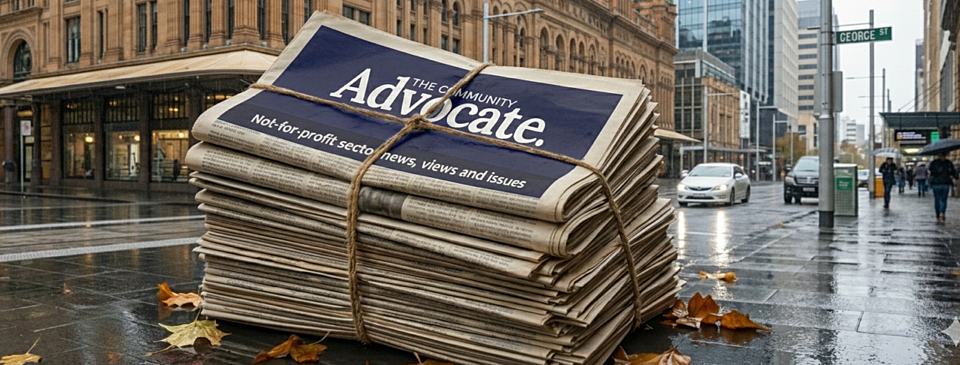
William Tilmouth wins Australia’s highest human rights award and condemns continuing Indigenous policies
Posted on 17 Dec 2025
The founding chair of the ambitious systems-change not-for-profit organisation Children’s Ground,…
Posted on 12 Dec 2023
By Greg Thom, journalist, Institute of Community Directors Australia

The number of Australians tipped into homelessness has surged over the past year, new figures show.
An analysis of Australian Institute of Health and Welfare statistics by Homelessness Australia revealed the trend is being driven by skyrocketing rents and record low vacancy rates.
The research showed that the number of homeless people seeking help increased by 5.5% in 2022–2023, threatening to overwhelm homelessness services.

The statistics also revealed:
The number of people transitioning from homelessness to private rentals dropped 2%.
Homelessness Australia CEO Kate Colvin said the statistics should serve as a wake-up call on the number of Australians doing it tough without a permanent roof over their head.
"These figures are a stark and alarming indicator of how the deepening housing crisis is pushing more Australians to sleep in their car, pitch a tent or couch surf,” she said.
“It’s very hard to work or learn when you have no roof over your head or a real prospect of getting a home.”
"Australians are facing a housing and cost of living crisis that is pushing more people into homelessness.”
Ms Colvin said data also revealed that homelessness service capacity barely increased in 2022–23, despite surging demand.

The number of homeless people supported across the year increased 1.3% from 272,694 to 273,648. A lot more people – 290,462 – were helped when funding to homelessness services was temporarily increased during the covid pandemic.
Ms Colvin said compounding the problem was a looming $73 million funding black hole for homelessness services.
This relates to federal funding for the Equal Remuneration Order (ERO) for homelessness services workers. The funding to supplement the wages of workers in the sector is due to expire in June 2024.
"Australians are facing a housing and cost-of-living crisis that is pushing more people into homelessness,” said Ms Colvin.
“Without more funding for critical homelessness first responders, we risk seeing these trends worsen, putting more Australians in jeopardy of experiencing the harsh realities of homelessness.”
As Canberra works on its National Housing and Homelessness Plan, Ms Colvin said Australia needs a realistic blueprint to end homelessness within a decade.
“Ending homelessness is entirely doable, as we saw during covid,” she said.
“We need substantial investment in social housing, sustained focus on the causes of homelessness, and a significant boost in funding for homelessness support services.”
An insiders view of life on the outside
Report reveals almost 40% of homeless children are young people
Decades on from landmark report, not much has changed for vulnerable kids, says homelessness hero

Posted on 17 Dec 2025
The founding chair of the ambitious systems-change not-for-profit organisation Children’s Ground,…

Posted on 17 Dec 2025
As we head into the holiday period, the number of Australians battling homelessness has hit crisis…

Posted on 17 Dec 2025
Posturing by the US president about Europe's immigration policies, even warnings of future…

Posted on 17 Dec 2025
For this final Community Advocate edition of the year, we reviewed a whole year’s worth of stories…

Posted on 16 Dec 2025
Lex Lynch spent more than two decades in the climate change and renewables field before last year…

Posted on 16 Dec 2025
As Australia prepares to welcome its one millionth refugee, human rights advocate and former…

Posted on 11 Dec 2025
Community Directors trainer Jon Staley knows from first-hand experience the cost of ignoring…

Posted on 10 Dec 2025
Adele Stowe-Lindner, Executive Director, Community Directors The Institute of Community Directors…

Posted on 10 Dec 2025
The Australia Institute has called on the federal government to force Australian businesses to be…

Posted on 10 Dec 2025
Economic empowerment is essential to enabling recovery, restoring agency and preventing future…
Posted on 10 Dec 2025
A long-time advocate for rough sleepers in northern New South Wales has been named her state’s…

Posted on 10 Dec 2025
What a year 2025 has been, particularly at a national level where the Parliament and politics as we…